[English] 日本語
 Yorodumi
Yorodumi- PDB-2xdf: Solution Structure of the Enzyme I Dimer Complexed with HPr Using... -
+ Open data
Open data
- Basic information
Basic information
| Entry | Database: PDB / ID: 2xdf | ||||||
|---|---|---|---|---|---|---|---|
| Title | Solution Structure of the Enzyme I Dimer Complexed with HPr Using Residual Dipolar Couplings and Small Angle X-Ray Scattering | ||||||
 Components Components |
| ||||||
 Keywords Keywords | TRANSFERASE / SUGAR TRANSPORT | ||||||
| Function / homology |  Function and homology information Function and homology informationphosphotransferase activity, nitrogenous group as acceptor / phosphoenolpyruvate-protein phosphotransferase / phosphoenolpyruvate-protein phosphotransferase activity / N-acetylglucosamine transport / antisigma factor binding / regulation of carbon utilization / positive regulation of glycogen catabolic process / phosphoenolpyruvate-dependent sugar phosphotransferase system / enzyme inhibitor activity / enzyme regulator activity ...phosphotransferase activity, nitrogenous group as acceptor / phosphoenolpyruvate-protein phosphotransferase / phosphoenolpyruvate-protein phosphotransferase activity / N-acetylglucosamine transport / antisigma factor binding / regulation of carbon utilization / positive regulation of glycogen catabolic process / phosphoenolpyruvate-dependent sugar phosphotransferase system / enzyme inhibitor activity / enzyme regulator activity / enzyme activator activity / kinase activity / metal ion binding / identical protein binding / cytosol / cytoplasm Similarity search - Function | ||||||
| Biological species |  | ||||||
| Method | SOLUTION NMR /  SOLUTION SCATTERING / simulated annealing SOLUTION SCATTERING / simulated annealing | ||||||
 Authors Authors | Schwieters, C.D. / Suh, J.-Y. / Grishaev, A. / Guirlando, R. / Takayama, Y. / Clore, G.M. | ||||||
 Citation Citation |  Journal: J Am Chem Soc / Year: 2010 Journal: J Am Chem Soc / Year: 2010Title: Solution structure of the 128 kDa enzyme I dimer from Escherichia coli and its 146 kDa complex with HPr using residual dipolar couplings and small- and wide-angle X-ray scattering. Authors: Charles D Schwieters / Jeong-Yong Suh / Alexander Grishaev / Rodolfo Ghirlando / Yuki Takayama / G Marius Clore /  Abstract: The solution structures of free Enzyme I (EI, ∼128 kDa, 575 × 2 residues), the first enzyme in the bacterial phosphotransferase system, and its complex with HPr (∼146 kDa) have been solved using ...The solution structures of free Enzyme I (EI, ∼128 kDa, 575 × 2 residues), the first enzyme in the bacterial phosphotransferase system, and its complex with HPr (∼146 kDa) have been solved using novel methodology that makes use of prior structural knowledge (namely, the structures of the dimeric EIC domain and the isolated EIN domain both free and complexed to HPr), combined with residual dipolar coupling (RDC), small- (SAXS) and wide- (WAXS) angle X-ray scattering and small-angle neutron scattering (SANS) data. The calculational strategy employs conjoined rigid body/torsion/Cartesian simulated annealing, and incorporates improvements in calculating and refining against SAXS/WAXS data that take into account complex molecular shapes in the description of the solvent layer resulting in a better representation of the SAXS/WAXS data. The RDC data orient the symmetrically related EIN domains relative to the C(2) symmetry axis of the EIC dimer, while translational, shape, and size information is provided by SAXS/WAXS. The resulting structures are independently validated by SANS. Comparison of the structures of the free EI and the EI-HPr complex with that of the crystal structure of a trapped phosphorylated EI intermediate reveals large (∼70-90°) hinge body rotations of the two subdomains comprising the EIN domain, as well as of the EIN domain relative to the dimeric EIC domain. These large-scale interdomain motions shed light on the structural transitions that accompany the catalytic cycle of EI. | ||||||
| History |
| ||||||
| Remark 700 | SHEET DETERMINATION METHOD: DSSP THE SHEETS PRESENTED AS "AB" IN EACH CHAIN ON SHEET RECORDS BELOW ... SHEET DETERMINATION METHOD: DSSP THE SHEETS PRESENTED AS "AB" IN EACH CHAIN ON SHEET RECORDS BELOW IS ACTUALLY AN 9-STRANDED BARREL THIS IS REPRESENTED BY A 10-STRANDED SHEET IN WHICH THE FIRST AND LAST STRANDS ARE IDENTICAL. THE SHEETS PRESENTED AS "BB" IN EACH CHAIN ON SHEET RECORDS BELOW IS ACTUALLY AN 9-STRANDED BARREL THIS IS REPRESENTED BY A 10-STRANDED SHEET IN WHICH THE FIRST AND LAST STRANDS ARE IDENTICAL. |
- Structure visualization
Structure visualization
| Structure viewer | Molecule:  Molmil Molmil Jmol/JSmol Jmol/JSmol |
|---|
- Downloads & links
Downloads & links
- Download
Download
| PDBx/mmCIF format |  2xdf.cif.gz 2xdf.cif.gz | 924.4 KB | Display |  PDBx/mmCIF format PDBx/mmCIF format |
|---|---|---|---|---|
| PDB format |  pdb2xdf.ent.gz pdb2xdf.ent.gz | 789.8 KB | Display |  PDB format PDB format |
| PDBx/mmJSON format |  2xdf.json.gz 2xdf.json.gz | Tree view |  PDBx/mmJSON format PDBx/mmJSON format | |
| Others |  Other downloads Other downloads |
-Validation report
| Summary document |  2xdf_validation.pdf.gz 2xdf_validation.pdf.gz | 407.9 KB | Display |  wwPDB validaton report wwPDB validaton report |
|---|---|---|---|---|
| Full document |  2xdf_full_validation.pdf.gz 2xdf_full_validation.pdf.gz | 617.3 KB | Display | |
| Data in XML |  2xdf_validation.xml.gz 2xdf_validation.xml.gz | 74.4 KB | Display | |
| Data in CIF |  2xdf_validation.cif.gz 2xdf_validation.cif.gz | 104.7 KB | Display | |
| Arichive directory |  https://data.pdbj.org/pub/pdb/validation_reports/xd/2xdf https://data.pdbj.org/pub/pdb/validation_reports/xd/2xdf ftp://data.pdbj.org/pub/pdb/validation_reports/xd/2xdf ftp://data.pdbj.org/pub/pdb/validation_reports/xd/2xdf | HTTPS FTP |
-Related structure data
- Links
Links
- Assembly
Assembly
| Deposited unit | 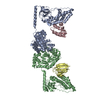
| |||||||||
|---|---|---|---|---|---|---|---|---|---|---|
| 1 |
| |||||||||
| NMR ensembles |
|
- Components
Components
| #1: Protein | Mass: 63419.344 Da / Num. of mol.: 2 Source method: isolated from a genetically manipulated source Source: (gene. exp.)   References: UniProt: P08839, phosphoenolpyruvate-protein phosphotransferase #2: Protein | Mass: 9129.332 Da / Num. of mol.: 2 Source method: isolated from a genetically manipulated source Source: (gene. exp.)   References: UniProt: P0AA06, UniProt: P0AA04*PLUS, Transferases; Transferring phosphorus-containing groups; Protein-serine/threonine kinases |
|---|
-Experimental details
-Experiment
| Experiment |
| |||
|---|---|---|---|---|
| NMR experiment | Type: TROSY-BASED 1H-15N CORRELATION SPECTROSCOPY |
- Sample preparation
Sample preparation
| Details | Contents: 90% H2O/10% D2O |
|---|---|
| Sample conditions | pH: 7.4 / Pressure: 1.0 atm / Temperature: 310.0 K |
-Data collection
| NMR spectrometer | Type: Bruker DRX / Manufacturer: Bruker / Model: DRX / Field strength: 800 MHz | |||||||||||||||||||||||||||
|---|---|---|---|---|---|---|---|---|---|---|---|---|---|---|---|---|---|---|---|---|---|---|---|---|---|---|---|---|
| Soln scatter | Data analysis software list: GNOM / Protein length: 16 / Temperature: 298 K
|
- Processing
Processing
| NMR software |
| |||||||||
|---|---|---|---|---|---|---|---|---|---|---|
| Refinement | Method: simulated annealing / Software ordinal: 1 Details: REFINEMENT DETAILS CAN BE FOUND IN THE PRIMARY CITATION. THE INITIAL STRUCTURE OF THE EI DIMER COMPLEXED WITH HPR WAS CONSTRUCTED AS A HYBRID OF THE CRYSTAL STRUCTURE OF PHOSPHORYLATED EI ...Details: REFINEMENT DETAILS CAN BE FOUND IN THE PRIMARY CITATION. THE INITIAL STRUCTURE OF THE EI DIMER COMPLEXED WITH HPR WAS CONSTRUCTED AS A HYBRID OF THE CRYSTAL STRUCTURE OF PHOSPHORYLATED EI INTERMEDIATE CAPTURED BY THE INHIBITOR OXALATE (PDB CODE 2HWG) AND THE NMR STRUCTURE OF THE EIN-HPR COMPLEX (PDB CODE 3EZA). THROUGHOUT THE STRUCTURE DETERMINATION, THE BACKBONE ATOMIC COORDINATES OF EACH EIN-HPR COMPLEX (RESIDUES 1-254 AND 601-685) WERE TREATED AS RIGID BODIES, WITH THE TWO SYMMETRY RELATED EIC DOMAINS (RESIDUES 262- 573) HELD FIXED IN SPACE. COORDINATES IN THE LINKER REGION (RESIDUES 255-261) WERE ALLOWED VARYING DEGREES OF FREEDOM DURING THE CALCULATION THROUGH THE USE OF THE INTERNAL VARIABLE MODULE (IVM) OF XPLOR-NIH. THE ENSEMBLE OF CALCULATED STRUCTURES FELL IN TWO CLUSTERS, THE REGULARIZED REFINED MEAN OF EACH IS INCLUDED BELOW AS MODELS 1 AND 2, RESPECTIVELY. STRUCTURAL STATISTICS: CLUSTER 1: SAXS CHI2 Q->0.44 0.63+/-0.11 SAXS CHI2 FULL RANGE FIT 0.45+/-0.07 SANS CHI2 1.38+/-0.51 RDC R-FACTOR 16.30+/-0.03 % RDC DA 13.73+/-0.05 HZ RDC RHOMBICITY 0.63+/-0.00 MODEL 1: SAXS CHI2 Q->0.44 0.62 SAXS CHI2 FULL RANGE FIT 0.42 SANS CHI2 1.30 RDC R-FACTOR 16.27 % RDC DA 13.74 HZ RDC RHOMBICITY 0.63 STRUCTURAL STATISTICS: CLUSTER 2 SAXS CHI2 Q->0.44 0.76+/-0.07 SAXS CHI2 FULL RANGE FIT 0.48+/-0.06 SANS CHI2 2.97+/-0.62 RDC R-FACTOR 16.25+/-0.02 % RDC DA 13.83+/-0.08 HZ RDC RHOMBICITY 0.63+/-0.00 MODEL 2 SAXS CHI2 Q->0.44 0.78 SAXS CHI2 FULL RANGE FIT 0.49 SANS CHI2 2.82 RDC R-FACTOR 16.25 % RDC DA 13.85 HZ RDC RHOMBICITY 0.63 | |||||||||
| NMR ensemble | Conformer selection criteria: BEST EXPERIMENT FIT, AND THEN LOWEST ENERGY Conformers calculated total number: 120 / Conformers submitted total number: 2 |
 Movie
Movie Controller
Controller


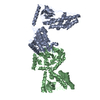









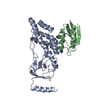



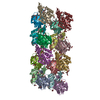
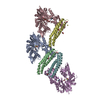

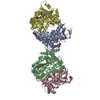
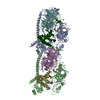
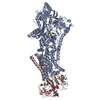

 PDBj
PDBj
